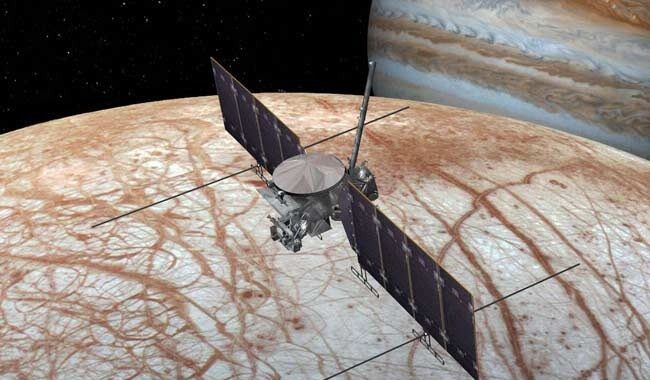Could the enormous, long-hidden oceans of our own Solar System be alive with extraterrestrial life?
On Thursday, the JUICE spacecraft from Europe launches on a mission to study the frozen moons of Jupiter, beginning a new chapter in humanity’s search for extraterrestrial life.
These ice-covered moons were first spotted by Italian scientist Galileo Galilei more than 400 years ago, but due to their great distance from the Sun, they were long disregarded as potential planets for life on Earth.
According to French astronomer Athena Coustenis, one of the scientific mission leads for the European Space Agency’s JUICE mission, until recently it was believed that the habitable zone of the Solar System “ended at Mars.”
However, the 1995 Jupiter mission of NASA’s Galileo probe and the more recent Saturn mission of the Cassini spacecraft forced scientists to widen their perspectives.
Although the gas giant planets themselves had been accurately ruled out, their icy moons, particularly Jupiter’s Europa and Ganymede and Saturn’s Enceladus and Titan, presented renewed hope for the existence of extraterrestrial life.
Huge oceans of liquid water, a necessary component for life as we know it, are believed to exist beneath their ice surfaces.
It would be “the first time that we explore habitats beyond the frost line,” according to Nicolas Altobelli, a JUICE project scientist at ESA, between Mars and Jupiter.
Altobelli told AFP earlier this year that temperature drops precipitously beyond that point and liquid water “can no longer exist on the surface.”
The “gigantic” ocean
On Thursday, the Jupiter Icy Moons Explorer (JUICE) mission will begin its eight-year journey into space from Europe’s spaceport in Kourou, French Guiana.
It will have orbited Jupiter by July 2031, from whence it will study Ganymede, Europa, and Callisto, another icy moon.
JUICE will become the first spacecraft to circle a moon other than our own when it enters Ganymede’s orbit in 2034.
In addition to being the largest moon in the Solar System, Ganymede is also the only one with a magnetic field of its own, shielding it from harmful radiation.
This is only one of many indications that Ganymede’s undiscovered ocean might offer a stable home for life.
Scientists anticipate that life will still exist in Jupiter’s ice moons, even if it is little or single-celled, in contrast to missions to Mars that concentrate on looking for evidence of extinct ancient life.
A power source is necessary for such habitability. The moons could use Jupiter’s gravitational pull on its satellites to supplement their lack of solar energy.
According to Carole Larigauderie, leader of the JUICE project at the French space agency CNES, the “gigantic” liquid ocean that covers Ganymede is encased between two substantial layers of ice hundreds of kilometres below the planet’s surface.
The bottom of the abyss is where we still find living forms on Earth, she continued.
There is optimism that other life will be able to thrive without sunlight because it has been discovered that tiny germs like bacteria and archaea can.
Life requires nutrients in addition to water and energy.
Therefore, Coustenis added, “the big question is whether Ganymede’s ocean contains” the essential chemical components.
She said, “The ocean would have to be able to absorb the nutrients from anything that fell on the surface of the moon, for instance, which would eventually dissolve into the water.”
not by themselves
To ascertain the ocean’s depth, separation from the surface, and — perhaps — its composition, JUICE’s arsenal of equipment will explore Ganymede.
The eight-month orbit of Ganymede will take the ESA’s 1.6 billion euro ($1.7 billion) probe as close as 200 kilometres (125 miles) near the moon while remaining shielded from radiation.
The spacecraft that will be circling Jupiter won’t be the only one.
Next October is the planned launch date for NASA’s Europa Clipper project. Europa will be reached in 2030 thanks to a shorter route to Jupiter.
According to Cyril Cavel, JUICE project manager at maker Airbus, sending a mission to land on the surface would be the “logical next step” if one or more of Jupiter’s moons meet all the requirements to support life.
“That’s part of the dream,” he said, even if there are currently no plans for a mission that could conclusively demonstrate the presence of life outside of Earth.







